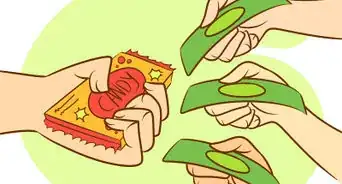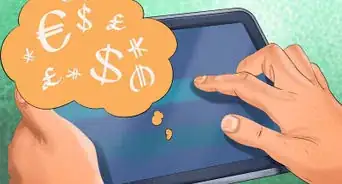This article was co-authored by wikiHow Staff. Our trained team of editors and researchers validate articles for accuracy and comprehensiveness. wikiHow's Content Management Team carefully monitors the work from our editorial staff to ensure that each article is backed by trusted research and meets our high quality standards.
This article has been viewed 19,340 times.
Learn more...
Postal orders—often referred to as money orders in the U.S.—allow for a quick transfer of funds from 1 person to another within the United Kingdom. They can also be cashed by anyone with or without a bank account. If you’ve been sent a postal order, it means that someone has prepaid that amount of money with cash or a debit charge. Cash the postal order by visiting a local bank or post office to retrieve the money.
Steps
Handling the Logistics
-
1Visit your local post office or a bank to cash the order. You must visit a post office or a bank to retrieve the money that you’ve been sent. Check online to find out the office’s normal business hours before you visit. Postal orders in the UK cannot be cashed at grocery stores or convenience stores.[1]
- If you’ve recently moved within the UK and are not sure where the nearest branch is, just enter your postcode online at: https://www.postoffice.co.uk/branch-finder.
-
2Cash in the postal order within 6 months of the date when it was sent. A postal order is only valid for 6 months after the order was initially sent. If you fail to cash a postal order within 6 months, the order will be void and you will not be able to get your money. So, make a note on the calendar or write yourself a note to cash the note soon.[2]
- It’s also worth noting that uncollected postal orders are not returned to the original sender. The postal office retains the money.[3]
Advertisement -
3File an official claim for your postal order if it’s lost or stolen. Postal orders are on relatively small slips of paper, and it’s not uncommon for them to go missing. If you misplaced your order, visit your local post office and ask for form P58. Fill out the information which includes your name, the name of the postal order’s sender, and the amount of money that the order was for. Then, get a copy of the original postal order receipt from the sender. Send both the form and the receipt to the address below.[4]
- Postal Order Correspondence Team
Method of Payment Team
Post Office Ltd.
Future Walk
Chesterfield
S49 1PF - You’ll receive a reply within 35 business days.
- Postal Order Correspondence Team
Getting Cash for Your Postal Order
-
1Sign the back of the paper slip to validate the postal order. Before cashing the postal order, you must sign your name on the back of it, just like you would when depositing a check. Sign your name exactly how it’s made out on the front of the postal order.[5] For example, if the front of the order doesn’t include your middle name, you don’t need to sign your middle name.
- Make sure to sign in blue or black ink pen. If you sign in pencil, marker, or a different color of ink, the clerk or teller may not accept the postal order.
-
2Show a form of legal ID if the clerk requests to see identification. While it isn’t technically required for you to show identification before receiving a money order, the post office clerk will ask for ID in most situations. This is especially the case if you’re cashing in a crossed postal order. Show the clerk your driver’s license, passport, or other legal ID, and they’ll allow you to cash in the order.[6]
- Within the UK, there are 2 types of postal order: crossed and uncrossed. Uncrossed orders can be either cashed or deposited into a bank account. Crossed postal orders can only be paid into the recipients’ bank account. They cannot be cashed. You can tell if your order is crossed or not by taking a look at it: crossed postal orders have 2 straight vertical lines running through it near the center.
-
3Pay the mandatory fee before receiving your money. The post office makes money on postal orders by charging a small fee for every order that’s cashed. If you don’t have any cash on hand, don’t worry. The bank or post office can simply deduct the fee out of the total value of the postal order that you’re cashing.[7]
- Within the UK, postal orders can be sent in any amount up to £250. The person cashing the postal order will be charged a small fee corresponding with the amount of money they’re receiving. For example, an order between £5–£9.99 will have a corresponding fee of £1.00, while an order between £10.00–£99.99 will come with a fee equal to 12.50% of the order’s value.[8]
-
4Cash an uncrossed postal order to get the money in-hand. Uncrossed postal orders are popular partly because they’re quick, efficient, and can be turned into instant cash. If you need some quick money, ask the post-office clerk or bank teller to give you the cash equivalent of the uncrossed postal order.[9]
- Whether or not a postal order is crossed depends on the person who sent the postal order to you. Crossed postal orders are considered more secure than uncrossed ones, since the money must be deposited in a bank account and cannot be taken as cash (i.e. it cannot be stolen from you). On the other hand, uncrossed postal orders are quicker to cash and more convenient.[10]
-
5Deposit a crossed order directly into your bank account. As a security measure, crossed postal orders cannot be cashed but can only be deposited into a bank account. Keep in mind that some post offices won’t be able to make the financial transfer into your bank account, so head to your bank to make the deposit.[11]
- If you still want hard cash, you can make a withdrawal from your account for the amount of the postal order.
References
- ↑ https://www.postoffice.co.uk/postal-orders-faqs
- ↑ https://www.telegraph.co.uk/money/jessica-investigates/wont-post-office-let-cash-postal-order/
- ↑ https://www.telegraph.co.uk/money/jessica-investigates/wont-post-office-let-cash-postal-order/
- ↑ https://www.postoffice.co.uk/postal-orders-faqs
- ↑ https://www.nerdwallet.com/blog/banking/money-orders/
- ↑ https://www.postoffice.co.uk/postal-orders-faqs
- ↑ https://www.thebalance.com/cash-a-money-order-315049
- ↑ https://www.postoffice.co.uk/postal-orders
- ↑ https://www.postoffice.co.uk/postal-orders-faqs
-Step-1-Version-2.webp)
-Step-2-Version-2.webp)
-Step-3-Version-2.webp)
-Step-4-Version-2.webp)
-Step-5-Version-2.webp)
-Step-6-Version-2.webp)
-Step-7-Version-2.webp)
-Step-8-Version-2.webp)




























































